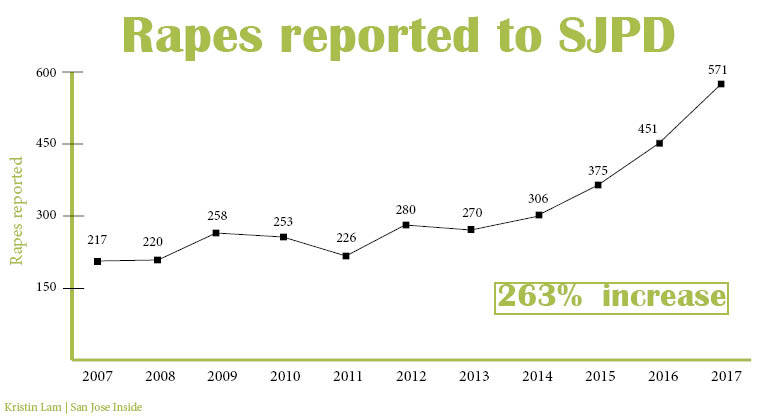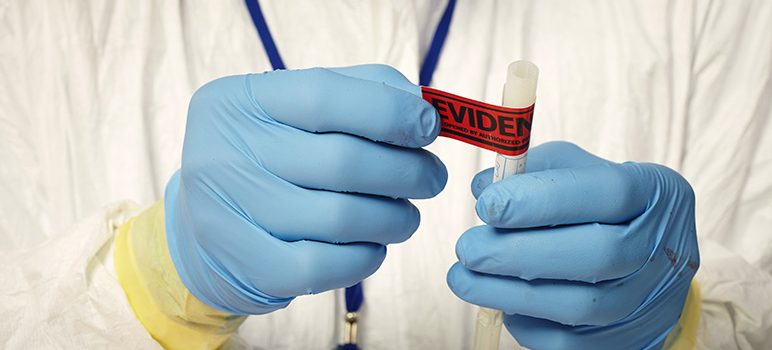Napoleon Manzano found his underage victims on Snapchat, authorities say. In December 2017, the 21-year-old San Jose man allegedly used the app to lure two girls, ages 13 and 14, to his house on separate occasions, where he plied them with weed and alcohol before raping them.
The San Jose Police Department arrested Manzano last month on felony charges of lewd acts with a child, oral copulation, rape by force and sexual penetration and a misdemeanor charge of contributing to the delinquency of a minor. It’s the kind of case involving online connections that San Jose police say they encounter more often.
Yet, such investigations can only partly account for the 263 percent increase in the number of rapes reported to SJPD in the past decade—from 217 in 2007 to 571 last year. That’s the highest level of reported rapes since the early 1990s, according to the FBI’s annual Uniform Crime Report. San Jose’s year-to-year increase stands at odds with national figures. According to the U.S. Department of Justice’s National Crime Victimization Survey, sexual violence nationwide has fallen by 63 percent since 1993, from a rate of 4.3 assaults per 1,000 people to 1.6 per 1,000 in 2015.
Lt. Jason Ta, head of SJPD’s 28-member Sexual Assault Investigation Unit, declined to speculate about what’s driving San Jose’s dramatic spike in reported assaults, saying that’s something for crime analysts to figure out. SJPD Chief Eddie Garcia, however, says the rise in rape reports doesn’t necessarily reflect an increase in the number of assaults.
“I think it has to do with our victims having more access to resources, lack of fear in reporting and having someone to lean on to help them through the process,” Garcia says.
 In addition to the surge in online dating-related, or social media-related assaults, local rape crisis centers say the #MeToo movement has emboldened more victims to come forward. YWCA Silicon Valley CEO Tanis Crosby says that’s definitely driving at least some of the trend.
In addition to the surge in online dating-related, or social media-related assaults, local rape crisis centers say the #MeToo movement has emboldened more victims to come forward. YWCA Silicon Valley CEO Tanis Crosby says that’s definitely driving at least some of the trend.
“We have certainly experienced an increase in requests for support as a result of the Me Too movement,” Crosby says. “I hope it is a sign that survivors are getting the support that they are choosing for themselves and that more people are aware of the support that is available and accessible to survivors.”
Historically throughout the U.S., only 5 to 20 percent of rapes get reported, according to the Rape, Abuse and Incest National Network. Most survivors never go to authorities because they don’t believe law enforcement will help them, per the nonprofit advocacy network. Or, more often than not, they worry about retaliation.
Indeed, fear of retribution has historically prevented survivors from speaking up—especially since the vast majority of them were victimized by a personal acquaintance. Garcia says 74 percent of adults and 80 percent of juveniles who reported rape in San Jose knew their attackers. He says SJPD depends on its partnerships with crisis centers and nonprofits to encourage victims to come forward.
“We can’t do this on our own,” Garcia says. “We know it’s an incredible violation when this occurs. Our victims need help, many times, to come forward.”
It’s possible that San Jose’s collaboration with victim advocates has prompted more survivors to contact police. Another factor that may be contributing to the higher reporting rate is that the legal definition of rape has changed.
For more than eight decades, the FBI classified “forcible rape” as “the carnal knowledge of a female forcibly and against her will.” In 2013, it reclassified the crime as “penetration, no matter how slight, of the vagina or anus with any body part or object, or oral penetration by a sex organ of another person, without the consent of the victim.” Naturally, that broadened the scope of the crime. The FBI estimated that the old terminology excluded 40 percent of rapes.
San Jose did see a sharper spike in rape reports following the FBI’s revised definition—from 270 in 2013 to 306 in 2014, 375 in 2015 and 451 in 2016—but the trend predated the semantic shift. From 217 reported assaults in 2007, the SJPD fielded 220 in 2008; 258 in 2009; 253 in 2010; 226 in 2011 and 280 in 2012.
According to San Jose Inside’s analysis, several cities in Santa Clara County saw an uptick in the number of recorded assaults—in the past decade overall and after the FBI updated its definition.
The Santa Clara County Sheriff’s Office, which polices the unincorporated parts of the region, saw a nearly 150 percent increase in rape reports from 2007 to 2017, and a jump from 13 recorded assaults in 2013—the year the FBI revised the definition of rape—to 36 the following year. In the city of Santa Clara, which has a population of about 130,000, the number of reported rapes went from 32 in 2007 down to zero in 2011 and a high of 35 in 2017. From 2013 to 2014, the number of reported assaults spiked from 13 to 28.
Palo Alto’s reported rapes went from one in 2007 to a high of 13 in 2015 and down to 10 by the latest available count in 2016 for the city of about 65,000 residents. The numbers have held fairly steady in Milpitas, a town of 76,000, where reported assaults have gone from a low of six in 2009 to a high of 14 in 2014 and have since hovered in the single digits. Sunnyvale (population: 150,000) went from 15 reported assaults in 2007 to a peak of 29 in 2015 and again last year; Campbell (population 43,000) from eight in 2007 to 17 in 2016; Cupertino (population 31,000) began and ended the decade with seven reported rapes; Saratoga (population 61,000) from two to a high of four in 2014; Mountain View (population 78,000) from eight up to 14 and then down to nine by the last tally.
While SJPD has no definitive answer for what’s leading to the increased number of reported assaults, Ta says his unit is constantly working on preventive measures. The national Internet Crimes Against Children Task Force works with Ta’s unit to train teenagers who may be vulnerable to sexual exploitation through social media such as Snapchat or Facebook. Sexual assault detectives also provide survivors with resources and referrals to advocate services depending on their cases.
“If we see certain patterns that could be considered reckless, we try to bring that to their (survivors’) attention,” Ta says. “We try to see if they can try to change the way they do things to cause them to be less apt to be victimized with regard to dating apps or other things like that.”
That heightened focus on prevention may be encouraging more people to turn to police to report crimes, says Crosby, of the YWCA. Assemblyman Evan Low (D-Campbell), who authored legislation last year to raise money to process untested rape kits, says agencies must ramp up outreach to underserved communities to make it easier for them to notify police when a crime occurs. LGBTQ folks or those who speak English as a second language face barriers to support services, he explains, and undocumented immigrants also fear reporting because of the threat of deportation.
“We need to make sure that we have a safe environment,” Low says, “not only in the workplace but also at home, where people feel like there are policies in place that do not support retaliation and allow for these things to occur in a safe and protective fashion.”


You will see a spike in reports followed by an increased convictions, then a drop in reports, thats how the criminal justice system works. However, you have to report them to the police, not the National Institute of Justice. Or they just keep on raping and assaulting.
Decriminalize consenting adult commercial sex where no one reports being a victim so that there are more resources available for victims who ask for help. When cops spend their time pursuing consenting adults for engaging in commercial sex (looking for ‘sex trafficking’ victims of which there were confirmed 595 in 2016 in the entire US), those who are real victims of crimes of rape and sexual assault lose.
In violent crimes such as rape, sexual assault, domestic violence, robbery etc. the victim MUST report the crime before the police will investigate… why not for cases of ‘suspected prostitution’ or ‘suspected sex trafficking’? Are the lives of sex workers more important to the criminal justice system than victims who ask for help? BTW there were 323,450 reported rapes and sexual assaults in 2016, and 1,109,610 reported incidents of domestic violence.
What about the children who are sex trafficking victims? Well, according to a government report on ‘Commercial Sexual Exploitation of Children in the US, Canada and Mexico”- 96% of all cases of child sexual exploitation is at the hands of someone the child knows and trusts, such as priests, preachers, teachers, coaches, neighbors, babysitters, parents, step parents, boyfriends of the mother, cops, etc. Fewer than 4% of cases are at the hands of a stranger and of those, a small percentage who are seeking to pay for their predations.
Where are the parents control with these two girls? Sisters? I guess it doesn’t matter but they obviously know how to use a computer. I hate that term, “they were obviously asking for it.” Not when they’re that young and a 21-year old that should know better. The penalty? Who knows these days? If convicted at the very least ‘sex offender for life.’ Plus some sort of jail time, which will just add to his education system. Since this type of dating system is now available, we can expect more of the same.
Two thoughts, Early release programs to save money and overcrowding, and Sanctuary City Status.
There are no problems in this country that were not created by or encouraged by politicians.
Keep voting for the same people, you will get the same results!